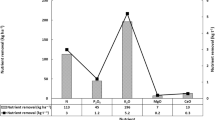Abstract
Yield response curves were developed for potatoes (Solanum tuberosum cv. Russet Burbank) with sprinkler-applied N fertilizer on a high-frequency schedule. The potatoes were grown on a Quincy sand to loamy sand (mixed, mesic, Xeric Torripsamments) typical of sandy-textured soils of the center-pivot irrigated areas of the Columbia River Basin of Oregon and Washington. These soils require daily irrigation at peak evapotranspiration because of low water-holding capacity. Yields were measured for total quantities of N, ranging from 100 to 665 kg N/ha, applied in small frequent increments as a urea-NH4NO3 solution. Maximum tuber yields ranged from 67 to 85 Mg/ha in 6 experiments over a period of 6 years. Economically optimum yields were obtained at fertilizer rates between 300 and 400 kg N/ha depending on cost-price ratio of N fertilizer and potatoes. Fertilization in this range should optimize tuber yield and quality with fertilizer N efficiency and economic return on fertilizer investment.
Resumen
Se desarrollaron curvas de rendimiento para papas (Solanum tuberosum cv. Russet Burbank) como respuesta a la aplicación, por aspersión, de fertilizante nitrogenado, en un programa de alta frecuencia. Las papas fueron cultivadas en arena o migajón arenoso Quincy (mezclado, mesic, Xeric Torripsamments) típico de los suelos con textura arenosa de las áreas irrigadas centrales de la cuenca del río Columbia de Oregón y Washington. Estos suelos requieren ser irrigados diariamente a máxima evapotranspiración debido a su baja capacidad de retentividad de agua. Los rendimientos fueron medidos para las cantidades totales deN, variando de 100 a 665 kg N/ha, aplicados en incrementos frecuentes y pequeños como una solución de úrea — NH4NO3. El máximo de los rendimientos en tubérculos varió de 67 a 85 Mg/ha en 6 experimentos en un período de 6 años. Económicamente, se obtuvieron rendimientos óptimos con cantidades de fertilizante entre 300 y 400 kg N/ha dependiendo de la relación costo/precio del fertilizante nitrogenado y las papas. La fertilización en estos límites debe optimizar el rendimiento en tubérculos y la calidad con la eficiencia del fertilizante nitrogenado y el ingreso económico en la inversión hecha en el fertilizante.
Similar content being viewed by others
Literature Cited
Bremmer, J.M. 1965. Inorganic forms of nitrogen.In: C.A. Black (ed.). Methods of soil analysis. Part 2 Agronomy monograph no. 9. Am Soc Am; Madison, WI.
Dow, A.I., A.R. Halvorson, R.E. Thornton and S. Roberts. 1974. Fertilizer guide for irrigated potatoes for Central Washington. Coll Agric Washington State Univ Coop Ext Bull FG-7.
Kleinkopf, G.E. and D.T. Westermann. 1982. Scheduling nitrogen applications for Russet Burbank potatoes. Univ Idaho Coll Agric Current Info Series No. 637.
Kunkel, R., M. Campbell and R. Thornton. 1972. Potato fertilizer and moisture management—what’s needed? Proc Washington State Potato Conf. p. 87–98.
Lauer, D.A. 1983. An automated metering system for experimental application of sprinkler-applied nitrogen fertilizer. Soil Sci Soc Am J 47:340–342.
Lauer, D.A. 1983. Line-source sprinkler systems for experimentation with sprinkler-applied nitrogen fertilizers. Soil Sci Soc Am J 47:124–128.
Lesczynski, D.B. and C.B. Tanner. 1976. Seasonal variation of root distribution of irrigated, field-grown Russet Burbank potato. Am Potato J 53:69–78.
Middleton, J.E., S. Roberts, D.W. James, T.A. Cline, B.L. McNeal and B.L. Carlile. 1975. Irrigation and fertilizer management for efficient crop production on a sandy soil. Washington State Univ Coll Agric Res Ctr Bull 811. 10 pp.
Roberts, S., W.H. Weaver and J.P. Phelps. 1982. Effect of rate and time of fertilization on nitrogen and yield of Russet Burbank potatoes under center-pivot irrigation. Am Potato J 59:77–86.
Saffigna, P.G. and D.R. Keeney. 1977. Nitrogen and chloride uptake by irrigated Russet Burbank potatoes. Agron J 69:258–264.
Saffigna, P.G., D.R. Keeney and C.B. Tanner. 1977. Nitrogen, chloride, and water balance with irrigated Russet Burbank potatoes in a sandy soil. Agron J 69:251–257.
Saffigna, P.G., C.B. Tanner and D.R. Keeney. 1976. Non-uniform infiltration under potato canopies caused by interception, stem flow, and hilling. Agron J 69:337–342.
Tanner, C.B., G.G. Weis and D. Curwen. 1982. Russet Burbank rooting in sandy soils with pans following deep plowing. Am Potato J 59:107–112.
Author information
Authors and Affiliations
Additional information
Contribution from USDA, Agricultural Research Service, in cooperation with the College of Agriculture and Home Economics Research Center, Washington State University, Pullman. Scientific Paper No. 6332 of the latter.
Rights and permissions
About this article
Cite this article
Lauer, D.A. Russet Burbank yield response to sprinkler-applied nitrogen fertilizer. American Potato Journal 63, 61–69 (1986). https://doi.org/10.1007/BF02853683
Accepted:
Issue Date:
DOI: https://doi.org/10.1007/BF02853683




